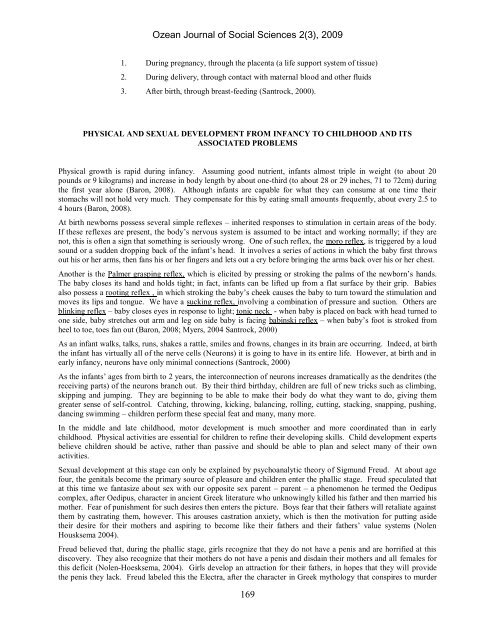Download complate issue - Ozean Publications
Download complate issue - Ozean Publications
Download complate issue - Ozean Publications
- No tags were found...
Create successful ePaper yourself
Turn your PDF publications into a flip-book with our unique Google optimized e-Paper software.
<strong>Ozean</strong> Journal of Social Sciences 2(3), 20091. During pregnancy, through the placenta (a life support system of t<strong>issue</strong>)2. During delivery, through contact with maternal blood and other fluids3. After birth, through breast-feeding (Santrock, 2000).PHYSICAL AND SEXUAL DEVELOPMENT FROM INFANCY TO CHILDHOOD AND ITSASSOCIATED PROBLEMSPhysical growth is rapid during infancy. Assuming good nutrient, infants almost triple in weight (to about 20pounds or 9 kilograms) and increase in body length by about one-third (to about 28 or 29 inches, 71 to 72cm) duringthe first year alone (Baron, 2008). Although infants are capable for what they can consume at one time theirstomachs will not hold very much. They compensate for this by eating small amounts frequently, about every 2.5 to4 hours (Baron, 2008).At birth newborns possess several simple reflexes – inherited responses to stimulation in certain areas of the body.If these reflexes are present, the body’s nervous system is assumed to be intact and working normally; if they arenot, this is often a sign that something is seriously wrong. One of such reflex, the moro reflex, is triggered by a loudsound or a sudden dropping back of the infant’s head. It involves a series of actions in which the baby first throwsout his or her arms, then fans his or her fingers and lets out a cry before bringing the arms back over his or her chest.Another is the Palmer grasping reflex, which is elicited by pressing or stroking the palms of the newborn’s hands.The baby closes its hand and holds tight; in fact, infants can be lifted up from a flat surface by their grip. Babiesalso possess a rooting reflex , in which stroking the baby’s cheek causes the baby to turn toward the stimulation andmoves its lips and tongue. We have a sucking reflex, involving a combination of pressure and suction. Others areblinking reflex – baby closes eyes in response to light; tonic neck - when baby is placed on back with head turned toone side, baby stretches out arm and leg on side baby is facing babinski reflex – when baby’s foot is stroked fromheel to toe, toes fan out (Baron, 2008; Myers, 2004 Santrock, 2000)As an infant walks, talks, runs, shakes a rattle, smiles and frowns, changes in its brain are occurring. Indeed, at birththe infant has virtually all of the nerve cells (Neurons) it is going to have in its entire life. However, at birth and inearly infancy, neurons have only minimal connections (Santrock, 2000)As the infants’ ages from birth to 2 years, the interconnection of neurons increases dramatically as the dendrites (thereceiving parts) of the neurons branch out. By their third birthday, children are full of new tricks such as climbing,skipping and jumping. They are beginning to be able to make their body do what they want to do, giving themgreater sense of self-control. Catching, throwing, kicking, balancing, rolling, cutting, stacking, snapping, pushing,dancing swimming – children perform these special feat and many, many more.In the middle and late childhood, motor development is much smoother and more coordinated than in earlychildhood. Physical activities are essential for children to refine their developing skills. Child development expertsbelieve children should be active, rather than passive and should be able to plan and select many of their ownactivities.Sexual development at this stage can only be explained by psychoanalytic theory of Sigmund Freud. At about agefour, the genitals become the primary source of pleasure and children enter the phallic stage. Freud speculated thatat this time we fantasize about sex with our opposite sex parent – parent – a phenomenon he termed the Oedipuscomplex, after Oedipus, character in ancient Greek literature who unknowingly killed his father and then married hismother. Fear of punishment for such desires then enters the picture. Boys fear that their fathers will retaliate againstthem by castrating them, however. This arouses castration anxiety, which is then the motivation for putting asidetheir desire for their mothers and aspiring to become like their fathers and their fathers’ value systems (NolenHousksema 2004).Freud believed that, during the phallic stage, girls recognize that they do not have a penis and are horrified at thisdiscovery. They also recognize that their mothers do not have a penis and disdain their mothers and all females forthis deficit (Nolen-Hoesksema, 2004). Girls develop an attraction for their fathers, in hopes that they will providethe penis they lack. Freud labeled this the Electra, after the character in Greek mythology that conspires to murder169
















